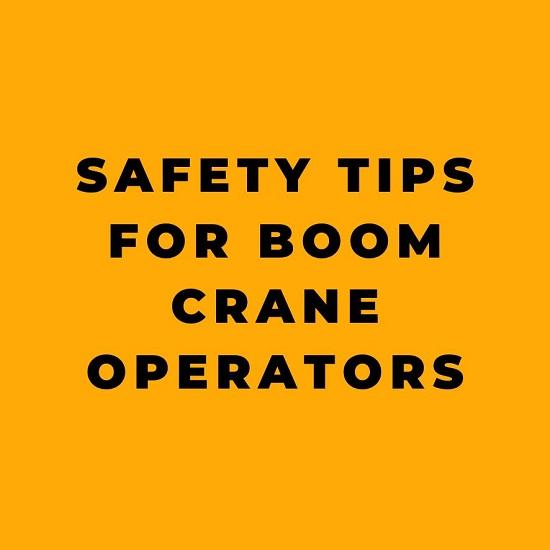Operating a boom crane is a high-risk job that requires careful attention to safety measures. Whether you are an experienced operator or new to the field, understanding and implementing safety tips for boom crane operation is paramount. In this comprehensive guide, we will explore a wide range of safety measures, best practices, and regulations that all boom crane operators should be well-versed in. From avoiding power line hazards to ensuring proper rigging, we will cover everything you need to know to operate a boom crane safely and efficiently.
Key Concepts and Background Information
Before we delve into the specific safety tips for boom crane operators, it’s essential to understand the inherent risks associated with crane operation. Boom cranes are used in various industries, including construction, manufacturing, and logistics, for lifting and moving heavy loads. The sheer size and power of boom cranes make them indispensable in many industrial settings, but they also pose significant risks if not operated with caution and expertise.
The Occupational Safety and Health Administration (OSHA) has identified several common safety hazards associated with crane operation, including accidental contact with energized power lines, overloading crane capacity, and the risk of materials falling. These hazards highlight the critical need for stringent safety measures and proper training for crane operators to mitigate the risks and ensure a safe working environment.
Safety Tips for Boom Crane Operators
1. Barricade the Swing Area and Mark It with Warning Signs
One of the fundamental safety measures for boom crane operation is to barricade the swing area of the crane and clearly mark it with warning signs. This is crucial to prevent unauthorized personnel from entering the danger zone and being exposed to potential hazards. By establishing a clearly defined perimeter around the crane’s swing area, operators can minimize the risk of accidents and injuries caused by unexpected movements of the crane.
2. Avoid Power Line Hazards
Accidental contact with energized power lines is a significant safety concern for boom crane operators. To mitigate this risk, operators should shut off the power line current if possible and make repeated visual checks of their position in relation to power lines. Additionally, maintaining a safe distance from power lines and adhering to OSHA guidelines for working near electrical hazards is essential for ensuring the safety of both the operator and the surrounding personnel.
3. Prevent Overloading and Ensure Proper Load Centering
Overloading a crane’s capacity can lead to catastrophic accidents, including structural failure and load instability. Boom crane operators must avoid raising the boom too high and ensure that the top block is centered over the load to prevent load swinging. Additionally, maintaining proper counterweight to prevent tipping is crucial for safe crane operation.
4. Use Tag Lines and Prevent Long Side-Pulls
When moving a load horizontally, operators should use tag lines to limit swinging and ensure controlled movements. It’s essential to position the boom to avoid long side-pulls, as excessive lateral forces can compromise the stability of the crane and lead to accidents.
5. Ensure Proper Outrigger Shoring and Rigging
Properly shored outriggers are essential for preventing tilting, which can cause a side-bend in the boom and compromise the stability of the crane. Rigging hoisted materials to prevent unintentional displacement and using hooks with self-closing safety latches are critical safety measures to prevent load-related accidents.
6. Rigging by Qualified Riggers and Load Release Caution
Before workers move into the fall zone to handle a load, it must first be rigged by a qualified rigger. Avoid the quick release of a load on a near-vertical boom, as this can lead to uncontrolled movements and potential hazards for personnel on the ground.
7. Complete Overhead Crane Maintenance
Regular maintenance of boom cranes is essential for ensuring their safe and efficient operation. Inspecting crane components, including brakes, clutch, boom splices, and braces, is crucial for identifying and addressing potential issues that could compromise safety.
8. Follow OSHA Guidelines and Obtain Proper Training
Adhering to OSHA guidelines and regulations is non-negotiable for boom crane operators. OSHA requires that only trained and certified personnel can operate cranes, emphasizing the importance of obtaining the right education and crane operation training. By following OSHA guidelines, operators can contribute to maintaining a safe working environment and preventing avoidable accidents.
9. Personal Protective Equipment (PPE) and Pre-Operational Inspections
Wearing the proper PPE, including hard hats, eye protection, and hand protection, is vital for safeguarding crane operators from potential hazards. Additionally, conducting pre-operational inspections of the crane before each shift is a statutory requirement in several countries and a crucial step in identifying any safety issues that need to be addressed before crane operation.
10. Never Stand Under a Load and Avoid Complacency
One of the most critical safety tips for boom crane operators is to never stand under a load. The risk of load swing, load drop, or an unstable load can lead to catastrophic accidents, making it imperative for operators to maintain situational awareness and avoid complacency during routine operations.
Conclusion
Operating a boom crane requires a high level of skill, expertise, and a deep understanding of safety protocols. By implementing the safety tips outlined in this comprehensive guide, boom crane operators can contribute to creating a safe and secure working environment while minimizing the risk of accidents and injuries. Adhering to OSHA guidelines, conducting thorough pre-operational inspections, and prioritizing safety at all times are essential for every crane operator. As the industry continues to evolve, staying updated on the latest safety regulations and best practices is critical for ensuring the well-being of all personnel involved in crane operations.










